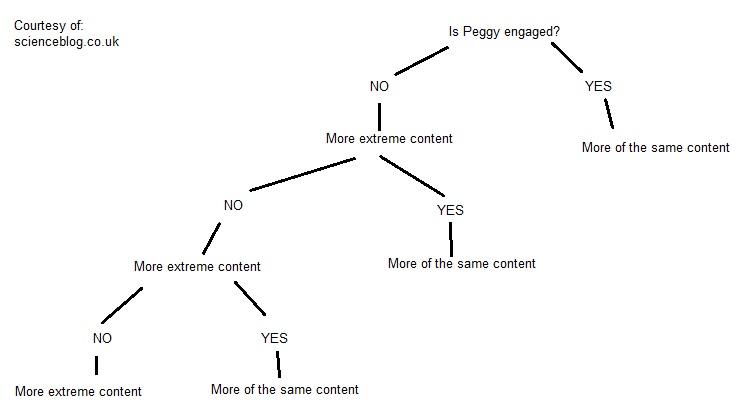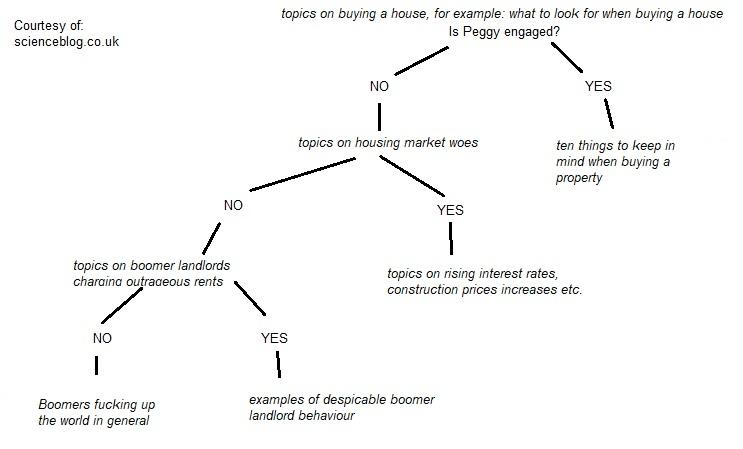| Getting your Trinity Audio player ready... |
The rise of Facebook (est. 2004) and Twitter (est. 2006), coupled with the coinciding increase in polarization, has been a hot topic in recent years. The basis of the discussion always seems to come down to striking a balance between profit and polarization.
Solutions on how to fix polarization have been proposed by many: activists, experts, interest groups and government representatives by making changes in the field of regulation, transparency and education.
But the real solution is simple: start scrolling stoned.
The social media polarization hypothesis
The general hypothesis of many of these research articles on social media and polarization usually focuses on the fact that it is these companies’ main goal to make money for their shareholders:
The profit motives of social media companies to increase engagement and user time spent on their platforms, coupled with the optimization of algorithms to prioritize and promote content that generates the most engagement, leads to the reinforcement and proliferation of polarized viewpoints on social media, resulting in a more polarized society.
But what are algorithms exactly? What basic principles underline an algorithm and how does Facebooks’ algorithm make it money while apparantly fuelling online hatred?
What are algorithms?
An algorithm follows a set of instructions or steps to solve a problem or accomplish a task. Various fields, including biology, medicine, and finance, utilize algorithms. In biology, researchers use algorithms to analyze genetic data and understand the functions of different genes. In medicine, doctors use algorithms to analyze medical images and aid in diagnoses. Professionals in the field of finance, use algorithms for tasks such as financial modeling and risk management. Some examples of specific algorithms in these fields include decision tree algorithms for medical diagnosis, algorithms for gene sequence alignment in genetics research, and algorithms for portfolio optimization in finance.
What types of algorithms are there?
There are many different types of algorithms, and this is a list of some of the most populair algorithms in use today:
- Search algorithms: These algorithms find specific items in a large data set, such as searching for a specific word in a document or finding a specific item in an e-commerce database. Examples include linear search and binary search.
- Sorting algorithms: These algorithms organize data in a specific order, such as alphabetical order or numerical order. Examples include bubble sort, insertion sort, and quicksort.
- Machine learning algorithms: These algorithms train computer systems to learn from data and make predictions or decisions without being explicitly programmed. Examples include linear regression, decision trees, and neural networks.
- Graph algorithms: These algorithms process data that is represented in the form of a graph. Examples include algorithms for finding the shortest path between two points in a graph and algorithms for finding the minimum spanning tree of a graph.
- Randomized algorithms: These algorithms use random numbers as an essential part of the logic to solve a problem or accomplish a task, they are used when no deterministic algorithm can be found or when a probabilistic approach is preferred. Examples include Monte Carlo methods and randomized quicksort.
- Approximation algorithms: These algorithms find approximate solutions of optimization problems, when finding the exact solution is either impossible or impractical. These are often used in fields such as operations research, computer science, and engineering. Examples include greedy algorithms and simulated annealing.
There are many more types of algorithms, such as cryptography algorithms, compression algorithms, and encryption algorithms.
How do social media platforms use these algorithms?
It’s important to note that social media platforms may use a combination of these algorithms for a more effective approach. Additionally, the effectiveness of each algorithm depends on the specific context and the way they are implemented. Social media companies also regularly update and improve these algorithms in order to enhance performance and user experience.
These algorithms help a platform with:
- Content recommendation: Algorithms recommend content to users based on their interests and behavior on the platform. This can include posts from friends and pages they follow, as well as posts that the algorithm determines may be of interest to the user.
- News feed curation: Algorithms determine the order in which posts appear in a user’s news feed. The algorithm takes into account factors such as the relevance of the post, the user’s past interactions with similar content, and the time the post was made.
- Search: Algorithms help users find content on the platform by ranking search results based on relevance.
- Trending: Algorithms identify popular topics and trends on the platform in real-time, and highlight them to users.
- Ad targeting: Algorithms match ads to users based on their interests and behavior on the platform.
- Content filtering: Algorithms filter content that goes against the platform’s community guidelines, for example, hate speech, harassment, and misinformation.
- Moderation: Algorithms flag, report and remove content that goes against the community guidelines.
- Personalization: Algorithms personalize the experience of the users on the platform, this can include targeting specific demographics, interests or behaviors.
Memes
On to the fun part: memes, a place where algorithms can really do their magic.
What are memes?
Richard Dawkins, in his 1976 book “The Selfish Gene,” coined the term “meme” to describe cultural elements that spread rapidly via the internet, often in the form of images or videos with text or captions. They can be comedic in nature and reference popular movies, TV shows, and other internet memes. Created and shared by literally anyone memes serve as a form of satire and social commentary. They connect people through shared understanding and humor and are an important part of internet culture.
Popular memes
Some of the most popular are:
- “Harambe” (2016) – a gorilla who was shot and killed at the Cincinnati Zoo after a child fell into its enclosure. The meme often features Harambe’s name as a way to express feelings of nostalgia or loss.
- “Doge” (2013) – a Shiba Inu dog with captions written in broken English and Comic Sans font. The meme often features phrases such as “such wow” and “very [adjective].”
- “Distracted Boyfriend” (2017) – a stock photo of a man looking at another woman while his girlfriend looks on in disapproval. People use this meme to comment on issues of infidelity or betrayal.
- “Expanding Brain” (2016) – an image of a brain growing in size with various captions describing increasing levels of intelligence.
- “Mocking SpongeBob” (2017) – a picture of SpongeBob SquarePants from the animated series “SpongeBob SquarePants” with text written in a mocking tone.
- “Pepe the frog” (2005) – an internet meme that became popular on 4chan and other online platforms. The meme typically consists of a picture of Pepe along with a caption written in broken English.
- “Dank Memes” (2015) – memes that are considered particularly funny or clever are referred to as “Dank Memes.”
- “Moth Meme” (2018) – A picture of a moth flying towards a lamp describes someone attracted to something, often in a humorous or ironic way.
- “Baby Yoda” (2019) – A character from the Disney+ series “The Mandalorian” quickly became popular and widely used in memes.
- “Arthur Fist” (2018) – An image of the character Arthur from the children’s show “Arthur” making a fist, typically used to express determination or anger.
Serving up the right meme for you
In order to serve up the right meme, social media platforms use algorithms that work with decision trees. As we’ve read earlier a decision tree algorithm is a type of machine learning algorithm.
It uses a set of input variables to analyze a set of data related to your preferences, browsing history, and other relevant factors to make a prediction about which meme you would engage with.
The algorithm creates a tree-like structure of decisions and outcomes, where each internal node tests an input variable, each branch represents the outcome of the test, and each leaf node represents a predicted outcome or class. The algorithm starts at the root node and traverses the tree by making decisions based on the input variables, until it reaches a leaf node that represents the final prediction.
The decision the algorithm makes is based on factors such as your age, location, browsing history and whether you previously showed interest in a certain type of meme (e.g. political memes, cat memes, etc.). The algorithm then makes further decisions based on specific features of the memes, such as length, tone, or keywords.
Decision tree algorithms are often paired with other machine learning techniques to improve their accuracy and robustness. This makes them powerful tools for making decisions based on complex data sets and predicting outcomes with high accuracy.
So how does scrolling stoned fix polarization?
How does this work? Well ofcourse, being stoned, as you know, makes you more prone to catch the giggles (and dumb you down?). This is not news, BUT…Memes I see while stoned differ from those I see sober.
My own experiment showed me stoned scrolling leads to more laughter, compared to sober scrolling.
I’ve visualized my findings in a decision tree, as used by algorithms.
Is Peggy engaged?
Visualized, the basic decision tree the algorithm uses in order to decide what to show me, looks like this:

If I don’t engage with the content, the algorithm keeps serving me more and more extreme content until it registers an interaction.
This ‘more extreme’ content depends on the profile a platform has of you. My profile would read a little something like this:
20-something millenial blogger with a Phd trying to buy a house but not succeeding, and venting her anger and frustration with passive agressive social media posts and by liking certain types of memes.
Now, this profile is based on all the interaction and information I’ve given on that social media platform.
By using this profile, I can further fill in my decision tree with some categories the algorithm uses to decide at which point in the decision-making tree it should serve me what content to increase the chances of me engaging.

The same decision tree can be made with different types of memes:

Ofcourse, the algorithms used by social media platforms mix all topics together to try and get you to engage: I’ll see memes and topics about the housing market fly by until I start to engage, at which point the algorithm will serve me up more of the same. But the deeper the decision tree goes, the less content is available. There are hundreds of thousands of universally funny memes and not as much layered political memes, so the algorithm still shows me some incendiary (boomer-related) topics on the housing market with which it thinks I am likely to engage.
Don’t worry, be happy
Now, as you’ve might have guessed: scrolling stoned made me like simple memes way more, and since there are a lot of them the algorithm kept serving me more and more and I’ve hadn’t these bursts of laughter scrolling through my timeline since I’ve been on social media. Scrolling stoned made me think: these algorithms are getting funnier and funnier, I love social media!
But the truth is: being more content, and laughing at simpler, innocent things, makes the algorithm serve up softer, gigglier content, and keeps you from going down the rabbit hole that is online polarization.
Next time you’re doom scrolling; like a few dumb memes you don’t actually find funny at the moment, because a gem might be waiting just around the corner!

One reply on “Fix Polarization: Start Scrolling Stoned.”
[…] When you think of algorithms, you’re probably thinking of Wall Street supercomputers whizzing around making thousands of calculations and transactions in a fraction of a second or social media companies monitoring your every click and comment, targeting you with ads and polarizing content. […]